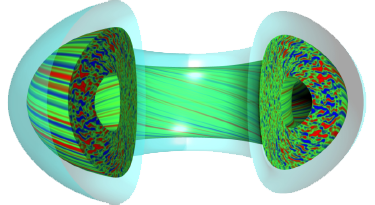Speaker
Description
A novel approach using Bayesian inference has been implemented using the Bayesian Framework
Minerva to interpret the filamentary dynamics measured by a Langmuir probe fixed to a
reciprocating assembly on MAST. The model describes the system as a superposition of time-
displaced filaments and a fixed background component. Each filament is parameterised in terms
of a characteristic rise and fall time and maximum amplitude centred on local maxima in the
measured data time-series. A distinctive feature of the approach is that no minimum threshold is
set for the existence of filaments. Furthermore, the model uncertainty is provided as an additional
free parameter. It is observed that whereas large amplitude filaments are well characterised in terms
of rise times, smaller amplitude filaments are often unconstrained by the data and are limited by
the details of the prior. Based on these findings, a new definition for the plasma filaments is
proposed based on the uncertainty in the filament rise times. The remaining filaments together
with the constant background component forms a new time-dependent signal referred to as the
computed background fluctuation signal (shown in the figure below). The characteristics of these
signals (for the plasma filaments and for the background fluctuations) are reported in terms of their
spatial variation as the probe moves through the SOL and into the core plasma.
| Country or International Organisation | United Kingdom |
|---|---|
| Affiliation | Physicist |

